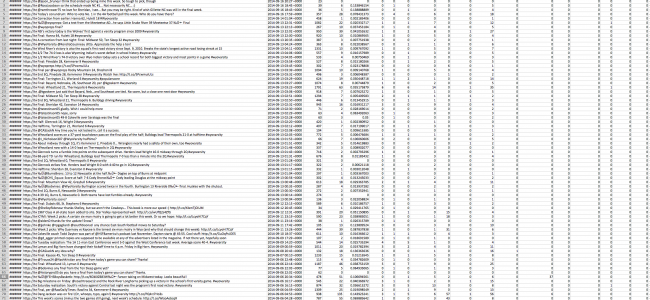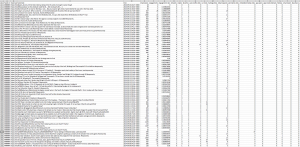In August, Twitter unlocked its analytics dashboard to the public. By going to analytics.twitter.com, anyone with a Twitter account can analyze their tweets to see what worked and what didn’t.
In my advanced writing course, we examine our individual Twitter accounts to look for successful tweets. That notion of “success,” though, has a variety of meanings.
For example, here’s a screenshot of the CSV file of the analytics for @wyomingfootball, a Twitter account I run for my website wyoming-football.com (click to see a larger version), over a 10-day period in September 2014:
As you can see, “success” can be defined many ways. Is “success” the most retweeted tweet? The tweet with the most impressions? The one with the highest engagement rate? The one with the most favorites? The one that leads to the most follows?
In this case, my most “successful” tweet is pretty clear… This tweet had the most impressions, the most retweets, the most favorites, the most profile clicks and created the most new followers. Despite being text only, it had the second-highest engagement rate (second only to a tweet with a photo) and a relatively high engagement rate.
Final: Wheatland 21, Thermopolis 6 #wyovarsity
— Wyoming-Football.com (@WyomingFootball) September 13, 2014
This is the winning tweet in this 10-day period…. Unless I’m defining “success” in ways beyond the numbers.
And this doesn’t even scratch the surface of promoted tweets, for which Twitter also provides analytics. Are the tweets I’m paying to promote worth the cost?
Twitter’s analytics are powerful, but we need to be careful in couching “success” with numbers. One of the ways I think my Twitter account is successful is when I tweet or retweet every score in the state on a Friday night. Consistency and thoroughness aren’t measured in Twitter’s analytics.
Analytics are a fantastic resource, but only when the numbers are part of the definition of success and not the be-all, end-all.
Just think of all the other ways can an individual tweet, or an entire Twitter account, can have “success” defined ways that can’t be measured by analytics.
Let’s talk about it: @pschmiedt

